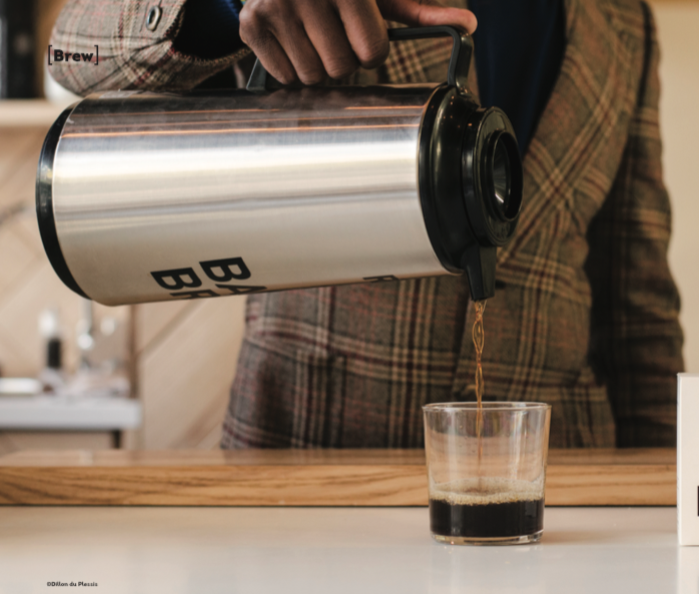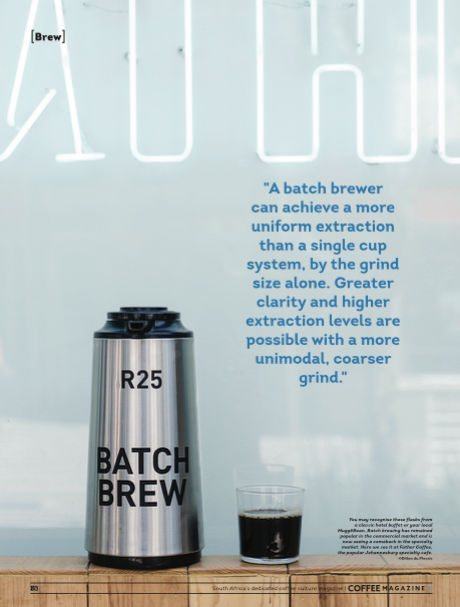Filter coffee has seen many incarnations through the years, but the filter coffee machine and the batch brew at cafes has perhaps been the most widely used. Through waves of espresso coffee culture and alternative filter methods, it appears this humble machine is making a comeback.
Words by Paul Whitehead, BUNN Coffee
Originally published in Issue 23 of The Coffee Magazine

When I started working in coffee, it was late in 2008 and the industry was about to explode.
Espresso was of course the focus – filter coffee had always been restricted to hotplates, glass jugs and tar-like brews. Then people started using Syphons, V60s and Chemex brewers - manual brewing started to be a calling card of the speciality industry.
In the last 10 years, it seems crazy how much the industry has changed and evolved.
Brewing filter coffee in 2018 can be as simple and complicated as a barista would like. In this article I’m going to pitch that batch brewing filter coffee is a technically superior to manual, and how it fits into a modern coffee service against the traditional manual techniques.
Technically better?
Let’s start with the technical points – what could make batch brewed coffee a technical improvement over manual brew?
Temperature stability – by brewing in a funnel under the machine, you are creating a closed environment, perfect for maintaining water temperature. Water is dispensed at a pre-selected temperature directly from the water tank. This means temperature is stable and consistent throughout a brew - Drop off over about 5% is only present at the end of a brew in batches over 4L. Compare this to a pouring kettle, often holding brew water for minutes at a time. Is it at 94c when it hits the coffee after 2 minutes? How quickly is that temperature lost to the air on a colder day versus a hot day?
Coarser Grinding – the larger the batch of coffee, the coarser the grind size can be. The coarser the grind, the less fines are present. This means a batch brewer can achieve a more uniform extraction than a single cup system, by the grind size alone. Greater clarity and higher extraction levels are possible with a more unimodal, coarser grind.
Consistency – a modern batch brewer has digital tools to assist a barista. Pulse brewing and bypass controls give maximum control – once programmed a brewer will repeat until told to do otherwise. In manual brew methods, scales and timers are required to track a brew, but ultimately one inconsistency or slip from a barista can result in large variance brew to brew.
Being in control of your brew before you even start gives batch brewing an edge – knowing the brew method is consistent makes recipe creation and adjustment much easier after taste and measurement of results.
How things used to be
Before I got into coffee, at the start of 2008, I was in my 5th year as a chef in the UK. The job was hard work with fortunately no customer service required!
When I started work as a barista, I saw similarities between being a chef in the main kitchen and my job. Orders come flying in, and you have seconds to prepare a perfect product from just 2 ingredients. The art of being a barista back then was doing it as consistently as possible, quickly. This was achieved by focussing on your ‘craft’, using manual tools and good judgement. Wastage was high, efficiency low.
In filter coffee, manual brewing was everything. Time and energy was spent using kettles, fonts and boilers, folding filter papers, pre-heating apparatus, pre-weighing doses, all to create a brew that might be ruined by the bar wobbling, an imperfect pour, a cold day, customer chat causing distraction.
Profit was low on these single cup drinks – so we bumped the price up to one that made sense. It didn’t make sense to the public though, so less people ordered. This meant that a single cup of filter coffee often took far longer than it should, and was a burden on a barista team in full flow.

Rise of the machines
Nowadays there is a focus on making baristas efficient. This is evidenced in espresso - grind to weight grinders, automatic tamping, gravimetric machines and textured milk dispensers. Espresso and milk process has theoretically been reduced to pressing 3 buttons and pouring.
Manual brewing has had little change to it. We still pre-weigh doses in piles of small pots, we still use hot water systems and kettles that lose heat, still aim for consistency in pouring, dosing, stirring, timing, weighing, knowing inside that it might not always happen…
High quality filter coffee can be brewed in advance on a batch brewer - dispensed with the pull of a tap in seconds. Batch brewing filter coffee saves time, effort and inefficiencies during service by enabling the barista to prepare as many drinks as they want prior service.
The skill-set of a modern barista making both espresso filter coffee is recipe creation, detailed coffee knowledge and the ability to calibrate equipment to deliver a quality product. The machine does the rest.
By using tools to make their service more efficient, a barista should have more time, less stress. What does this mean? I would suggest that a member of staff that is less stressed, less overloaded and less rushed can:
Some may say that theatre is lost through automation, particularly with batch brewers. I see the reasoning behind that on a purely aesthetic level – a thermal server is not the same as a glass carafe. Also, batch brewing can result in wastage when a batch expires, but far less in my opinion than having to re-brew and dial in coffees on a manual brew station.
I believe that the last skill of the barista, which was almost lost to toil and labour over individual drinks, is quality customer service. The theatre created by a happy, relaxed, knowledgeable and customer oriented barista is greater than that of a silent one, head down with a V60 and a kettle.